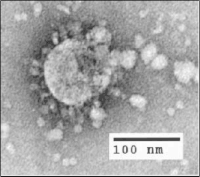
Photo from wikipedia
Abstract Background Human respiratory syncytial virus (RSV) is one of the most important pathogens that cause acute respiratory infections in children and immunocompromised adults. This work was conducted to understand… Click to show full abstract
Abstract Background Human respiratory syncytial virus (RSV) is one of the most important pathogens that cause acute respiratory infections in children and immunocompromised adults. This work was conducted to understand the epidemiological and phylogenetic features of RSV in southern China during 2011–2016. Methods A total of 16 024 nasopharyngeal swabs were collected from patients with respiratory infections in 14 hospitals, and screened for RSV and seven other respiratory viruses using real-time PCR. Six hundred and twenty-three RSV-positive samples from 13 hospitals were further analyzed for subtypes. G gene sequencing and phylogenetic analysis were performed based on 46 RSV-A and 15 RSV-B strains. Results RSV was detected in 9.5% of the 16 024 specimens, the highest among the eight respiratory viruses screened. Most of these specimens came from inpatients and children under 3 years of age. The incidence of RSV-A (9.4%) was higher than that of RSV-B (4.4%) in children (<15 years), but not in adults (0.64% vs. 0.58%). A 2-year RSV-A dominance followed by a 1-year RSV-B dominance pattern was found. The co-detection rate of RSV was 25.1%. The main prevalent genotypes were NA1, ON1, and BA9. The prevalent RSV-A genotype in 2011–2012 was NA1, close to Chongqing and Brazil, but a new Hong Kong ON1 genotype was introduced and became the prevalent genotype in Guangzhou in 2014–2015. Deduced amino acid sequence analysis confirmed the ongoing evolution and a high selection pressure of RSV-A and B strains, especially in RSV-A ON1 and NA1 genotypes. Conclusions This study demonstrated the molecular epidemiological characteristics of RSV in patients with respiratory infections in southern China.
Journal Title: International Journal of Infectious Diseases
Year Published: 2020
Link to full text (if available)
Share on Social Media: Sign Up to like & get
recommendations!